
- Homepage
- Blade Edge
- Blade Material
- 1095 Carbon Steel (7)
- 20cv (6)
- Bohler M390 (5)
- Carbon Steel (731)
- Cpm-20cv (11)
- Cpm-s30v (5)
- Cpm-s35vn (9)
- D2 Steel (6)
- Damascus (17)
- Damascus Steel (190)
- Elmax (9)
- Elmax Steel (5)
- Folded Carbon Steel (6)
- Folded Steel (34)
- High Carbon Steel (14)
- M390 (26)
- S35vn (19)
- S90v (7)
- Stainless Steel (462)
- Steel (8)
- Other (789)
- Blade Range
- Blade Type
- 0452cf (4)
- Cleaver (5)
- Clip Point (237)
- Dagger (7)
- Drop Point (334)
- Drop Point, Tanto (4)
- Harpoon (7)
- Hawkbill (17)
- Karambit (20)
- Leaf (13)
- Pen (6)
- Reverse Tanto (6)
- Sheepsfoot (29)
- Spear Point (78)
- Straight Back (8)
- Tanto (66)
- Trailing Point (10)
- Upswept (7)
- Upswept Skinner (3)
- Wharncliffe (74)
- Other (1431)
- Brand
- Artisan (17)
- Benchmade (51)
- Bestech Knives (57)
- Boker (37)
- Boker Plus (19)
- Case (28)
- Case Xx (55)
- Damascus (39)
- Fox (35)
- Kansept Knives (65)
- Kizer (25)
- Lionsteel (22)
- Qsp Knife (18)
- Sj Shi Jian (134)
- Sog (25)
- Spyderco (149)
- Swords' World (41)
- Viper (29)
- We Knife Co Ltd (19)
- Zero Tolerance (55)
- Other (1446)
- Dexterity
Japanese Samurai Katana Sword Kobuse Bare Blade Clay Tempered Folded Steel
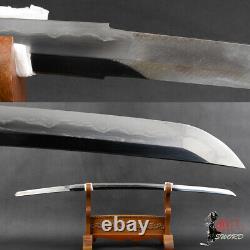

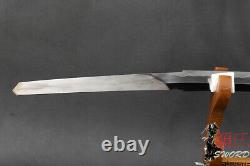

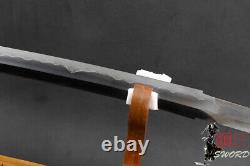

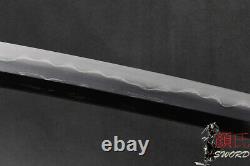

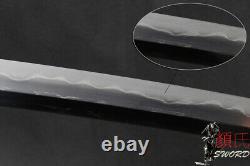
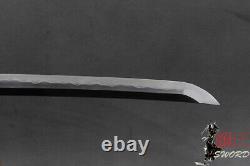
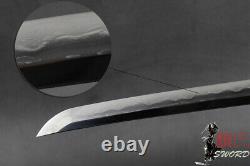



Japanese Samurai Katana Sword Kobuse Bare Blade Clay Tempered Folded Steel. 97.4 cm (38.35). NAKAGO LENGTH: 25 cm (9.8). 3.2 cm / 1.26. 0.7 cm (0.28). Fully hand forged, hand polished Shitaji togi +.
1095 carbon steel, folded 15 times. Real hamon, clay hardened line. 1 bare blade with habaki.
The kobuse is constructed of two different kinds of steel, the core steel and the outer steel, where the core steel is wrapped with the outer steel. As to the tempering, the outer steel is more sensitive than the core steel. In this case the outer steel is harder than the core steel. Before being quenched, a special clay mixture can be applied onto the blade to harden the edge and obtain different hardness on the blade.
The clay mixture was a special recipe and considered a crucial trade secret, guarded protectively by sword making masters. It would contain such things as feathers, powdered bones, grass, etc.
And would be applied to the edge of the blade before being quenched. During quenching, a chemical reaction between the clay mixture and the hot steel occurs during the sudden temperature drop and carbon is fed into the blade in.
High amounts, creating an extremely tough edge. A clay hardened blade can only be quenched in water, thus increasing the defect rate even more.
Another way for clay tempering is to apply clay along the blade but let edge exposed. Thus, while quenching the blade into water, the uncovered edge will cool down suddenly, but the rest of blade will cool down slowly.Such differential temperature change results in the different hardness of the blade. So the edge is tough enough to cut, where the back of blade is soft /flexible enough to absorb the impact during cutting.
Such quenching process usually will leave beautiful wavy tempered line on the blade, as known as "hamon" in Japanese swords term. Is divided into two stages. Is Foundation polishing, to correct any bends in the blade. Is the stage that places the mirrorlike finish on a blade. This sword used Shiage togi.
It is a elaborate process to the blade, it uses small grindstone to polish the blade by hand to make the blade mirrorlike, it is a time-consuming work, it can effectively increase the sword's monetary, historic, artistic, and functional value. The Modern Style Polishing Hadori Style Polishing?? It is designed to highlight the aesthetics of the blade. In this style polishing, the hamon appears white against the black, shining steel and the mirror finished shinogi-ji. It is so aesthetic that it makes a blade perfect for display. The white pattern that looks like hamon is called "HADORI". It is not a true hamon, but it is designed by polisher along the hamon to exaggerate it. When you look at the blade under a proper light, you can see the true hamon under the hadori. With the modern polishing style, you can see the blades with aesthetically "made-up face".This polishing style was developed by a famous polisher in the early 20th century. HOW TO DISASSEMBLE A JP SWORD. For engraving English words, Chinese characters and Japanese Kanji.
For engraving patterns dragon, lion, etc. Swords can be shaped by a variety of metalworking techniques.
The primary techniques are forging and stock removal. Forging uses heat to bring the material to a malleable state.
The material is then hammered to shape, typically using hammer and anvil together with specialized set and fuller tools depending on the particular technique. Stock removal shapes the sword from prepared stock that is larger in all dimensions than the finished sword by filing, grinding and cutting. After the blade has been shaped, the sword would be quenched.
We quench our swords in either water or oil. Water quenching produces a tougher edge which can also be hardened further more using clay. Blades quenched in oil are still considerably hardened and do have superior flexibility compared to a water quenched blade. The more rapidly a blade cools down, the harder it becomes.
Thus, when a hot blade enters the water, the water also gains heat and the blade will cool more gradually. Therefore, the first part of the blade that enters the water will be the hardest. Therefore, the technique of quenching was also very important.If a blade has any flaws from forging (air bubbles, ash), it will break immediately during the quenching process. After quenching, the sword will be quite tough and brittle, with little flexibility. To overcome this, the blade would undergo a tempering process.
The blade would be reheated to a certain temperature degree then allowed to cool naturally. The blade would be slightly less tough afterward but have a greater degree of flexibility - the art would be to perfectly balance the blade for toughness, sharpness and flexibility. Finishing encompasses polishing, decorating, and crafting and assembling the hilt, guard and sheath. The swordsmith would be most concerned with the state of the blade itself and possibly decorating the blade and preparing the guards and pommel. Other artisans would likely be involved in the work of fashioning the hilt, sheath and other furniture; and in any fine decoration.
When the rough blade is completed, the swordsmith turns the blade over to a polisher, whose job it is to refine the shape of a blade and improve its aesthetic value. The polishing process almost always takes longer than even crafting, and a good polish can greatly improve the beauty of a blade, while a bad one can ruin the best of blades. Early polishers used three types of stone, whereas a modern polisher generally uses seven. On high quality blades, only the back of the blade and the adjacent sides, are polished to a mirror-like surface. To bring out the grain and hamon, the center portion of the blade, and the edge are usually given a matte finish. Microscopic scratches in the surface vary, depending on hardness. Smaller but more numerous scratches in the harder areas reflect light differently from the deeper, longer scratches in the softer areas. The harder metal appears more matte than the softer, and the manner in which it scatters light is less affected by the direction of the lighting. After the blade is finished it is passed on to a mountings-maker for fashioning the hilt, sheath and other mountings. International Buyers - Please Note. This item is in the category "Collectibles\Knives, Swords & Blades\Swords & Sabers\Asian\Japanese".The seller is "yanli22" and is located in this country: CN. This item can be shipped worldwide.
- Type: Katana
- Tang: Full
- Dexterity: Right-Handed
- Edge: Single, Curved
- Handedness: Double-Handed
- Country/Region of Manufacture: China
- Theme: Samurai
- Brand: SJ SHI JIAN
- Blade Material: Carbon Steel
- Style: Japanese

